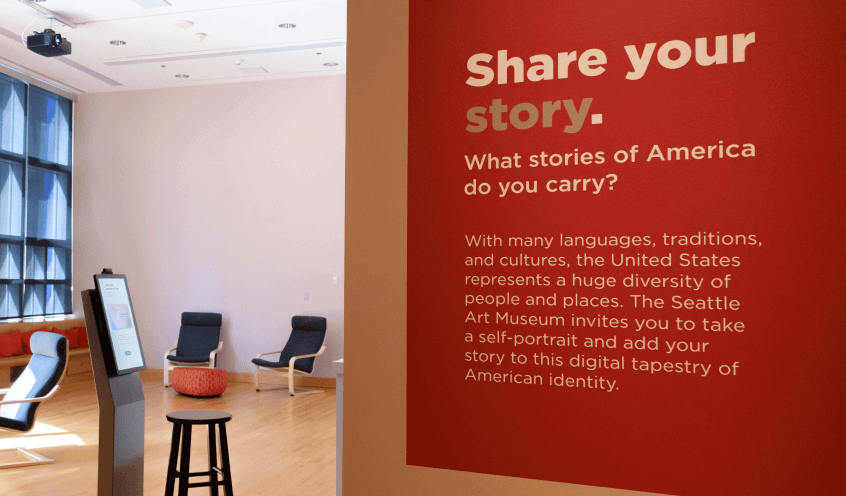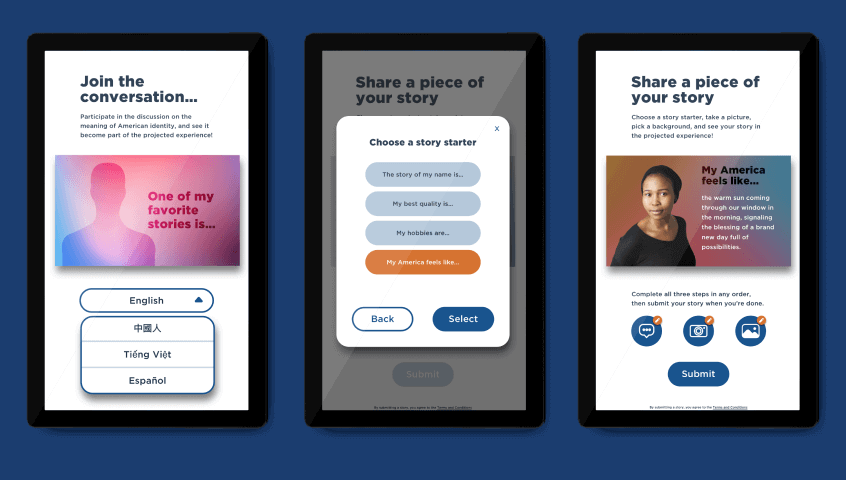The Seattle Art Museum (SAM) fosters creativity and builds community and welcoming experiences through art. They were re-imagining their American art collection with a lens towards equity and inclusion. The exhibition would be named “American Art: The Stories We Carry”. The SAM team felt some kind of visitor response or opportunity for visitors to connect with and to engage with what’s on display in an interactive way was needed.
Ramzy Lakos, Museum Educator for Digital Learning at SAM, provided context for this special project. “America is a tapestry. America is like a constellation of voices, of people, of identities. There’s a lot that goes into being American and that’s reflected in the stories that people hold onto, that they carry, that they pass down for generations. We wanted to connect to that idea in an interactive way. We wanted something that would give visitors an opportunity to share their story. To contribute their perspective.”

IMAGINATION: How Do You Make Visitors a Part of the Exhibit?
Ramzy and the team at SAM had a clear vision for an interactive exhibit they wanted to be a connection to “The Stories We Carry”, which later became the name of the exhibit. Ramzy described their key goals:
- Making the space fun, thoughtful, and interactive. “Art museums conventionally go one direction. It’s you receiving knowledge, you looking at artwork. We wanted to flip that. What can people put out there that they’re actually thinking about, that they’re challenging or engaging with ideas?”
- Making it feel welcoming. “We wanted visitors to feel welcome in the space, to feel invited to participate.”
- Making people feel represented. “We wanted visitors to feel represented within this idea of American identity, which is, I think, very fraught for some people. I think Americanness across the board is not something that everyone feels they can connect to. So we wanted the people to see a wide range, not only of identities, but also just different kinds of people. So if you go in and see someone that looks like you or speaks your language or feels the same way as you, that’s a powerful, connecting experience.”
While they had a clear vision, the team knew they didn’t have the in-house resources to make it a reality. They needed to find a firm that could handle the software development and technology pieces of taking a core idea and turning it into an experience, while being able to match the creativity of the artists and museum staff they would be working with. A colleague at SAM had worked with Chaos Theory at the Museum of Pop Culture (MPop) and recommended them to Ramzy as a creative and dynamic team that could bring his idea to life.

CREATION: Designing an Intuitive Experience that Creates Connection
Ramzy could immediately tell that our team loved projects that push the boundaries of what’s been done before. Creating a space that is immersive in a multi-sensory way brought our teams together for an incredible collaboration. Here’s how we worked together:

Imagine
The SAM team had a core idea, but needed help figuring out what was possible. Our team led brainstorming sessions with the key players. Ramzy was impressed with how free our team was with our time and how productive the sessions were (even virtual meetings). We gained a clear understanding of the project goals and the typical visitors at SAM. Together, we collaborated on ideation, developed user personas, and created a design brief.

Design
Once we defined the necessary architecture and detailed requirements for the final product, we kicked off an iterative design process. During this process, our designer would come up with a mockup of the UI and a storyboard of the step-by-step visitor experience. Ramzy was impressed with how fast we were able to turn around revisions to get to a final design.

Develop
Once our designs were approved we got to work creating the user stories that would define our development, working in an agile sprint cadence. The SAM team had some limitations on what could be built in the exhibit space, and Ramzy appreciated that we listened to and honed in on user needs and kept the excitement of the concept while also working within the limitations.

Deliver
While we delivered the technology, there was a lot more to this project than just having it work—it needed to work in the space. We performed full testing and QA of the completed solution, but we knew it needed to be tested after the exhibit was built. So we came back when it was and made adjustments needed to create a fabulous experience.

Deploy
We wanted SAM visitors to be wowed and to use this new exhibit. That’s why we stayed available to them to provide guidance and counsel as the exhibit went into use. We were by Ramzy’s side the weekend of the opening to ensure the exhibit worked and was well received by end users.
Technology Used:

Elo Touch Windows 10 IoT Enterprise Touch Screen Computer & BenQ Projector

React Web Application Running Linux with a PostgreSQL Database
What’s it like working with the Chaos Theory team?
Great Organization…
Ramzy knew this project was in danger of becoming ‘unwieldy or nebulous’ due to its scale and variety of components. Which is why he was grateful for our project management. “I feel like Chaos Theory really brought a lot of organization to this project. They were able to put parameters on it, a project timeline and schedule. This was instrumental in being able to carry it through from start to finish.”
…Lets the Experts Shine
Without having to worry about project management, Ramzy got to see the talent of our team. “Chaos Theory has a diverse range of talents. Jayme Hewitt was on top of keeping things organized as project manager. Chris Stevens has a strong vision as creative director and understands what it means for visitors to engage with interactive technology. From their tech team to design, they are a small but mighty team. They seem to have someone for everything and that really stood out to us.”
It wasn’t just that we had smart people. Ramzy was asked to describe our team in a few words. His response was humbling. “Chaos Theory is collaborative, innovative, warm, challenging, and fun.”
INNOVATION: Turning Visitors Into Contributing Artists
The final product created involves visitors coming up to a touchscreen kiosk where they can choose the language they want to engage in (English, Chinese, Vietnamese, or Spanish). Then, in any order, they can respond to a prompt and take a portrait. The system crops out the background and the user can choose a colorful background. The software aggregates the response, portrait, and background selection into a final submission (which can also be edited as desired). Once the visitor is happy, they submit and the result goes onto a large projection screen that shows submissions in a 3×3 grid. The submissions cycle out as more submissions are made.
Technically speaking: We created a multi-sensory, interactive experience to immerse visitors using an Elo Touch Windows 10 IoT Enterprise Touch Screen Computer & BenQ Projector React Web Application running Linux with a PostgreSQL database.
This was a passion project for Ramzy and he is extremely happy with the results. “It’s been really joyful for me to see this project come to life from our Zoom meetings and brainstorms and feedback sessions and actually be something physical in the space that visitors are engaging with. I’ve been just delighted to see how much people are engaging with this and how excited they are to have an opportunity to share their story.”
The space is fun, thoughtful, and engaging | It’s intuitive and visitors feel invited to participate | Visitors feel represented in the idea of America |
In the opening weekend, the museum had over 40 people engage and make a submission. “The experience itself is really intuitive to visitors that are encountering it for the first time. Even then, I’ve been happily surprised at our visitors’ range of creativity, vulnerability, and willingness to engage.”
The exhibit isn’t just a hit with visitors, staff at SAM has taken notice. “Anecdotally, I’m hearing from a lot of other staff members that go into that space and they’re like, ‘This is amazing! This feels like it ties it all together.’”
“I think the Chaos Theory team were great thought partners. They were gifted in taking the core of an idea and then moving into the nuts and bolts and bringing this idea to life.”

Ramzy Lakos
Museum Educator for Digital Learning, Seattle Art Museum
Relevant case studies
Augmented Reality
Microsoft HoloLens

We partnered with Stanford and Microsoft to create the first visualization of MRI data within the HoloLens. By giving surgeons the power to visualize data directly on the patient, as well as the size and location of the tumor, the Serra system shows the way toward increased accuracy and improved patient outcomes.
Interactive Experience
UNICEF Giga Project

UNICEF knew that the multitude of challenges in trying to create a connected world would require a solid data management foundation. The Project Giga data science team turned to Chaos Theory for the solution.
Transit
Community Transit

Community Transit, a public agency serving 5 million passengers annually in Snohomish County, Washington, realized that they needed to revamp their user experience to stay relevant in the digital age. Chaos Theory engineered a new suite of transit information tools to serve their users.

